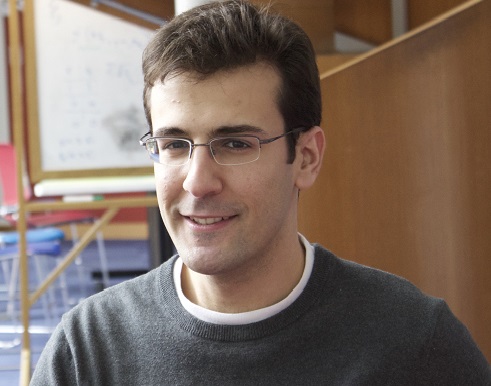

On any given afternoon, a visitor to LIDS might find a dark-haired, bespectacled graduate student pacing back and forth across the sun-drenched lounge, or staring out of the floor-to-ceiling windows.
Elie Adam isn't just daydreaming — he's lost in thought, perhaps about how failure propagates throughout interconnected systems, and the logical principles that underlie such cascades. And pacing is one of the ways he thinks best about his research.
Elie is a fifth-year graduate student at LIDS, where he works with Professors Munther Dahleh and Asu Ozdaglar.
Broadly, their team studies how large, interconnected networks such as power grids, financial markets, and transport systems might fail; looks to understand the theoretical underpinnings of how failures cascade through networks; and tries to develop more resilient networks for the future.
More specifically, Elie's work is on the second aspect — understanding the logic of cascade effects and the unexpected phenomena that emerge. Think of it as basic, fundamental research that underlies and has applications across many fields where complex systems are involved, from power grids to financial systems.
Each of these fields — grids, transport, and markets — is studied separately on its own, he explains. But they share an important aspect that needs to be understood. "There isn't a good foundation, a solid foundation, for people to understand how things propagate," he says. And as technologies in each of these fields become more complex, he thinks it's more and more essential to understand these systems rigorously.
But what are cascade effects? Elie likes to illustrate this with power grids. If one part of the grid fails, the electricity it carries gets redistributed to put pressure on other lines, which might fail in turn. That's the basic idea of a cascade.
Take electrical circuits for instance, with a power source and resistors throughout the circuit. If a resistor cannot endure the current passing through it, the resistor breaks; in turn, the current is distributed elsewhere in the circuit and other resistors may break.
It might be relatively easy to figure out the eventual outcome of a failure in one circuit or another. But what happens when multiple circuits are linked up? The outcome might be greater than simply combining the outcomes of each circuit. Instead, there can be unexpected consequences and failures, produced by the very interactions between the circuits.
"The question we would be interested in is: what configurations will our circuits go through? Will our circuits break down?" Elie says. "You have these systems, you combine them, and you get a gap between what you expect to happen without taking the interactions into account, and what actually happens." The goal is to "mend that gap," to extract some information or features from such interconnected systems to be able to say what will happen when systems interact.
And while it's possible with today's computing power to just simulate a simple system, Elie hopes to describe what happens mathematically. "In simple systems, simulating is fine. In larger systems, that.s not quite possible without guiding insight."
Ultimately, the goal of such theoretical work is to give insights into how connections between systems and structures affect an outcome — what might cause a larger system to fail or be resilient, where its weak spots are, and so on. Applied to real-world situations, that would help policymakers figure out where best to invest resources or shore up weak spots. For example, there have been tremendous advances in renewable energy technology, but less work has been done on integrating such technologies into a larger power grid and balancing between efficiency and resilience.
Growing up in Lebanon, Elie had a natural flair for mathematics and science. At the American University of Beirut, he studied computer and communications engineering, and was influenced in particular by three professors there who are LIDS graduates: Ibrahim Abou-Faycal, Fadi Karameh, and Louay Bazzi.
"I admired their rigor, skill, and knowledge.and that's why I wanted to come here," he says. In the long term, he hopes to stay in academia.
To relax and get away from work, Elie draws and paints; he'll sketch mostly for fun, but has also used his sketches for posters and presentation slides. He also dabbles in stone carving and practices karate with an MIT club.
He sees parallels between his hobbies and work. "For instance, if you think too hard about what you're drawing, you're going to make an awful drawing," he says. "So what you do is you forget everything and just do it. Now, to be able to develop the intuition to draw like that, you have to train." Likewise with karate, which involves repeated practice until the movements are intuitive. His research, which requires only pen and paper — and sometimes not even that — is a creative process that takes repeated cycles of practice and thought.
And he views problems not as things to be defeated, but to be gently pried apart and solved. "Don.t consider the problem to be an enemy that you want to crack, consider it to be more of a friend that you want to understand," says Elie. "You're just talking to that friend, and what you want to do is get to know that friend by asking questions, and then they give you back an answer. Sometimes that person doesn't want to talk, then you come back later and carry on the conversation."
It's a conversation carried out in his head, while patiently pacing the long blue carpets of the LIDS lounge. "I carry what I do with me all the time," he says. "It doesn't mean that I'm thinking about it all the time, but that I play with it, do something else, and come back to think about it."
That creative freedom is one of Elie's favorite aspects of his work. "I'm lucky I'm doing this sort of thing," he says.
